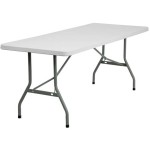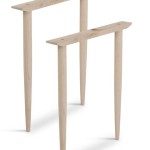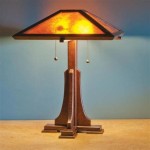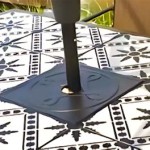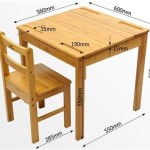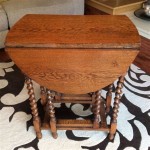How to Build a Coffee Table From Pallets: A Comprehensive Guide
Repurposing pallets into furniture is a sustainable and cost-effective way to furnish a home. A coffee table built from pallets offers a rustic aesthetic and can be customized to fit specific needs and preferences. This article provides a detailed guide on how to construct a functional and visually appealing coffee table using reclaimed wooden pallets.
Preparation and Material Acquisition
The initial step in building a pallet coffee table involves careful selection and preparation of the materials. This includes acquiring suitable pallets, gathering necessary tools, and implementing essential safety measures.
Pallet Selection: Not all pallets are created equal. It is crucial to select pallets that are structurally sound and free from significant damage, such as rot, excessive warping, or infestations. Pallets marked with the "HT" stamp indicate heat treatment, a safer alternative to chemical treatments like methyl bromide (MB), which should be avoided due to health risks. Look for pallets with clean, even wood grain and minimal signs of wear and tear. Consider the desired size and design of the coffee table when choosing the number and size of pallets. Standard pallet sizes vary, so measuring the available space and selecting pallets accordingly is advised.
Tool and Supply Gathering: Essential tools for this project include a circular saw or reciprocating saw for cutting the pallets, a hammer and pry bar for disassembling them, a drill with various drill bits for creating pilot holes and attaching hardware, a sander for smoothing the wood surfaces, a measuring tape for accurate dimensions, safety glasses to protect the eyes, work gloves to protect the hands, and a dust mask to prevent inhalation of sawdust. Necessary supplies include wood screws for securing the pallet pieces, wood glue for added strength, sandpaper of varying grits for smooth finishing, wood stain or paint for aesthetic enhancement, wood sealant or varnish for protection, and optional hardware such as casters for mobility and metal brackets or corner supports for reinforcement.
Safety Precautions: Prioritizing safety is paramount throughout the project. Wearing safety glasses is essential to protect the eyes from flying debris during cutting and sanding. Work gloves shield the hands from splinters and rough surfaces. A dust mask prevents the inhalation of fine wood particles, which can be harmful to the respiratory system. When using power tools, ensure that the work area is well-ventilated and free from obstructions. Securely clamp the pallets to a stable surface before cutting or disassembling them to prevent movement and potential injury. If utilizing a saw, maintain a firm grip and follow the manufacturer's safety guidelines. Exercise caution when using a hammer and pry bar to avoid accidental slips or impacts.
Construction Process
The construction process involves disassembling the pallets, preparing the wood, assembling the coffee table frame, and adding any desired customizations.
Disassembly and Preparation: Carefully disassemble the selected pallets using a hammer and pry bar. Working methodically, target the nails or staples that hold the pallet boards together. Apply even pressure to avoid splitting the wood. Once disassembled, inspect each board for any remaining nails or staples and remove them using pliers or a nail punch. Next, thoroughly clean the pallet wood using a brush and mild soap solution to remove dirt, grime, and any loose debris. Allow the wood to dry completely before proceeding to the next step. After cleaning, sand the pallet boards using progressively finer grits of sandpaper to create a smooth surface. Start with a coarse grit (e.g., 80-grit) to remove any rough edges or imperfections, then move to a medium grit (e.g., 120-grit) and finally a fine grit (e.g., 220-grit) for a polished finish. Pay particular attention to the top surface of the coffee table, ensuring it is as smooth as possible. Consider using a power sander to expedite the sanding process.
Assembly and Frame Construction: Determine the desired dimensions of the coffee table and cut the pallet boards to the appropriate lengths using a circular saw or reciprocating saw. Accurate measurements are crucial for achieving a square and stable frame. Lay out the cut boards to form the frame of the coffee table. The frame can be a simple rectangular shape or a more elaborate design with additional supports or decorative elements. Secure the boards together using wood screws and wood glue. Drill pilot holes before inserting the screws to prevent splitting the wood. Apply wood glue to the joining surfaces for added strength and durability. Clamp the frame together while the glue dries to ensure a tight bond. Once the frame is assembled, consider adding additional support braces to the interior of the frame for increased stability. These braces can be cut from scrap pallet wood and attached using screws and glue. After the glue has dried completely, inspect the frame for any gaps or imperfections and fill them with wood filler if necessary. Sand the filled areas smooth to create a seamless surface.
Customization and Finishing: The final stage involves customizing the coffee table to match the desired aesthetic and adding a protective finish. This includes staining or painting the wood, applying a sealant or varnish, and adding any desired hardware or decorative elements. Select a wood stain or paint that complements the décor of the room. Apply the stain or paint evenly using a brush, roller, or sprayer. Follow the manufacturer's instructions regarding drying time and the number of coats to apply. For a rustic look, consider using a weathered or distressed finish. Once the stain or paint is dry, apply a sealant or varnish to protect the wood from moisture, scratches, and stains. Choose a sealant or varnish that is appropriate for the intended use of the coffee table. Apply the sealant or varnish in thin, even coats, allowing each coat to dry completely before applying the next. Sand lightly between coats for a smooth finish. Consider adding casters to the bottom of the coffee table to make it easier to move. Attach the casters using screws or bolts, ensuring that they are securely fastened. If desired, add decorative elements such as metal brackets, corner supports, or a glass tabletop. Attach these elements using appropriate hardware and techniques.
Enhancements and Modifications
Beyond the basic construction, several enhancements and modifications can elevate the functionality and appearance of the pallet coffee table.
Adding a Lower Shelf: A lower shelf can provide additional storage space for books, magazines, or decorative items. To add a lower shelf, measure the distance from the bottom of the coffee table frame to the desired height of the shelf. Cut pallet boards to fit within the frame at this height. Attach the shelf boards to the frame using screws and glue, ensuring that they are level and securely fastened. Consider adding a trim piece around the edge of the shelf for a more finished look.
Incorporating a Glass Top: A glass top can protect the wood surface of the coffee table and add a touch of elegance. Measure the dimensions of the coffee table frame and order a custom-cut glass top that is slightly smaller than the frame. This will allow for a small gap around the edges. Attach rubber bumpers or spacers to the corners of the frame to prevent the glass top from sliding. Carefully place the glass top onto the frame.
Creating Hidden Storage: The coffee table can be modified to include hidden storage compartments for storing remote controls, blankets, or other items. This can be achieved by creating a hinged top or drawer within the coffee table frame. For a hinged top, attach hinges to one edge of the top frame and to the corresponding edge of the coffee table frame. Create a box or compartment underneath the hinged top to provide storage space. For a drawer, construct a drawer box that fits within the coffee table frame. Install drawer slides to allow the drawer to slide in and out smoothly. Add a drawer pull or knob to the front of the drawer for easy opening.
Adding Metal Accents: Incorporating metal accents can create a unique and industrial look. Consider adding metal brackets to the corners of the coffee table for reinforcement and visual appeal. Use metal pipe fittings to create legs or decorative elements. Attach metal mesh or expanded metal to the sides of the coffee table for a modern touch.
Building a coffee table from pallets is a rewarding project that combines sustainability with creativity. By carefully selecting materials, following sound construction techniques, and incorporating personal touches, a functional and stylish piece of furniture can be created.

Diy Pallet Wood Coffee Table

Diy Pallet Coffee Table Gets An Outdoor Makeover Southern Revivals

25 Diy Pallet Coffee Table Plans And Ideas How To

Mango Tomato Diy Make Your Own Pallet Coffee Table

Making A Coffee Table From Reclaimed Pallet Wood 5 Steps With S Instructables

The 62 Most Creative Pallet Coffee Tables For Your Inspiration 1001 Pallets

Diy Hardwood Pallet Coffee Table Woodworking Palletfurniture Coffeetable

Upcycled Diy Pallet Coffee Table Bring On The Cocktails Home Fixated

25 Diy Pallet Coffee Table Plans And Ideas How To

10 Diy Pallet Projects How To S And Guides

